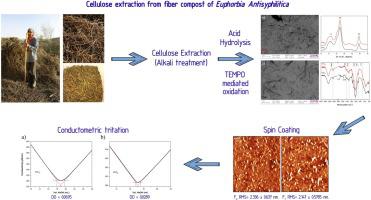Industrial Crops and Products ( IF 5.9 ) Pub Date : 2020-11-26 , DOI: 10.1016/j.indcrop.2020.113111 Eder U. Pulido-Barragán , Ana B. Morales-Cepeda , Carlos F. Castro-Guerrero , Andreas Koschella , Thomas Heinze

|
The utilization of organic industrial wastes as source for production of cellulose nanocrystals (CNCs) is very attractive and has a huge advantage in comparison with traditional sources as plants, bacterial or commercial cellulose (MCC), because it has the potential of increasing the value chain of these materials. The aim of this study is to analyze the utilization of Euphorbia Antisyphilitica bagasse, a waste of the wax industry, as source for CNC’s prepared by two different techniques, namely acid hydrolysis and TEMPO mediated oxidation. Cellulose extraction was performed by a treatment with aqueous NaOH followed by a bleaching process with NaClO. The samples were characterized by X-ray diffraction, Fourier transform infrared spectroscopy, thermogravimetric analysis, scanning electron microscopy, and conductometric titration. The CNCs samples have a diameter of around 17 nm and a length between 220 and 310 nm with a degree of crystallinity above 70 % and a very different thermal behavior depending of the isolation method. On one hand charge densities are 2.135 e/nm² and 1.933 e/nm², on the other hand root-mean-square roughness is around 2.1 and 2.3 nm (films were deposited on a glass surface), depending on the isolation technique.
中文翻译:

大戟抗梅毒纤维堆肥的升级:废料变成了纳米晶纤维素
利用有机工业废料作为生产纤维素纳米晶体(CNC)的来源非常有吸引力,并且与传统的植物,细菌或商业纤维素(MCC)来源相比,具有巨大的优势,因为它具有增加价值链的潜力这些材料。这项研究的目的是分析大戟抗梅毒的利用蔗渣是蜡工业的一种废料,它是通过两种不同的技术(即酸水解和TEMPO介导的氧化)制备的CNC原料。通过用NaOH水溶液处理,然后用NaClO进行漂白处理来进行纤维素提取。通过X射线衍射,傅里叶变换红外光谱,热重分析,扫描电子显微镜和电导滴定对样品进行表征。CNCs样品的直径大约为17 nm,长度在220到310 nm之间,其结晶度超过70%,并且热行为取决于隔离方法。一方面,电荷密度为2.135 e /nm²和1.933 e /nm²,另一方面,均方根粗糙度约为2.1和2.3 nm(薄膜沉积在玻璃表面上),具体取决于隔离技术。


























 京公网安备 11010802027423号
京公网安备 11010802027423号